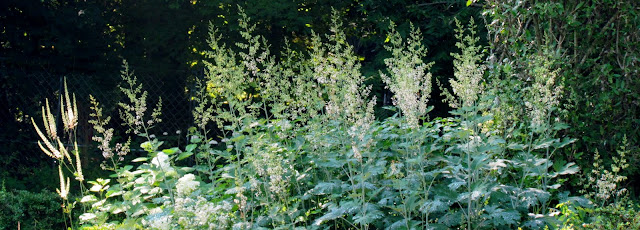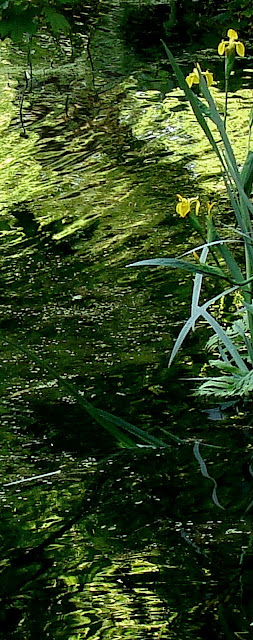THE OVAL
When I moved onto the land there was no Oval Garden.
What was there was unappealing and not much to look at. From the house, what i could see was a tall 8 foot high fence with behind it a dilapidated trailer. In it lived an older couple who had been given the right to live there for the rest of their lives. The couple had moved there in 1968, the closing days of the Camp. Rip van Winkle Camp for Catholic Boys was started here on the land in 1919 and went out of business, deep in debt, in 1968. It was the era of hippies and flower power. Kids didn't want to go to summer camp any longer and the Camp died.
This lovely elderly couple had been hired as the groundskeepers but there was very little for them to do. After bankruptcy, the main house became home first to groups of local hippies from Woodstock, 15 miles away and then to three couples from the City with heaps of children. When I arrived in High Falls in 1982, the main house was in deplorable state, caused more by lack of interest and investment than structural weakness.
When the caretaker couple died unexpectedly, the plot became available to me as a blank canvas. I had been mixing paints on my imaginary palette for many years before that. The place where the trailer stood was very central part of the land and I had been making great plans for it for many years.
Here was the chance to start a complete and new garden from scratch. The borders I had been putting together and laying out before were more like small plots that somehow got linked because I needed space for the 'new' plants I had bought.
The dimensions of the space that became available were roughly 25 by 35 meters (75 by 105 feet). By any standard that is impressive for a plot you want to cultivate by yourself, but size has never intimidated me. The house that came with the land had 22 rooms in it and I loved the idea to tackle all of those too.
It was not only the plot itself that became available but also the area behind it up until the edge of the woods that was to be part of the new garden lay-out.
Where the stone wall is now at the far end of the Oval, the land came down in a slope. A bulldozer cut away the slope in the shape of a crescent. From the small blue stone quarry 500 meters from the house, a friend and i gathered enough stone to build the retaining dry wall. The stones from this little quarry are very flat not bulky, which makes it easy to stack them on top of each other. We picked up each stone and puzzled it into place.
The stones are stacked on top of each other without cement. Hence the name dry wall. It is built leaning back into the earth so as to push back the pressures of the soil behind it. The back of the stone wall is filled with rubble to make it one with the earth. All walls in upstate New York are built that way. Even the foundations of houses. Along many narrow country roads here there are miles and miles of drywall stone hedges gathered and built by farmers hundreds of years ago to prepare the grounds for cultivation.
The final phase of the wall structure were the stone steps themselves. They are thick cut slabs of blue stone and are very heavy. With some leverage and my trusted pick axe I managed to put them into place and when I was finished I was awed by the majesty of it. A structure made out of unwieldy rough stone poured and puzzled into a curved, almost moving, form.
With the outer edge of the new garden drawn, making and building a new garden was next. I first had to finish the final shape of the garden. It did not have a final shape yet, only the outer semi-circular edge. Principles of design often suggest to mirror an existing shape and that is what we did. We flipped the crescent over to make an Oval. Question was how big to make it because I knew I was not going to hire garden staff to do the real work. I decided to make it big. I like big.
In the woods surrounding the garden, barberry bushes grow far and wide. They are indigenous and the waxy red berries of autumn make them easy to propagate anywhere. The bushes have short sharp thorns on wiry branches and once established form an impenetrable shield. A good defense against invasive deer and when clipped tightly a sharply drawn frame for the garden to shine in.
The transplanted barberry established themselves within a year and formed a dense magnificent hedge within three.
Of course the Oval started out as a very young garden, with nothing growing in it. Because it was so big to begin with and to make it manageable, it was essential to divide it into parts, each part separated by a path. Seven paths in total, and each part given a name, from Primus through Septimus.
When a garden is young it has no soul because nothing of substance is there other than good intentions and great plans. It has no character or personality yet. It may have its architectural elements which is nice when seen from the sky, but its population, the plants, have not developed enough to make a statement.
The enormity of the project requires patience. Time is what makes a garden. If I plant a 3 year old purple beech 6 feet tall, it will not establish its persona until about 15 years later when it becomes a strong but still young silhouette in its environment.
A young garden has no story, no history. Nothing has grown or bloomed here before. The locus has no past. A locus is essential in a garden to identify the location. "I'm by the weeping peach. I need to pull the weeds by the roses behind the stone bench in the Alpha Garden." The spot becomes the identifier, essential to the garden.
I prefer to spend my time where the trees are old, the plantings established, sculpted into the environment, old piles, weathered things.
The Oval had none of that in the early years. It is new, young and inexperienced. There have been no major disasters or victories here. Yet.
As with the planting of a tree, the Location of the Oval itself was the result of a visual inspection.
What I did is what I do whenever I introduce a new plant or tree into the High Falls Garden. I look up and imagine myself to be the newly introduced plant in our home and determine whether I can be happy in this spot. Will I have all the rain I need? Will I have all the sun I need? Will I get enough shade?
I'll look around and see where the sun is at what time of day. If there is an area exposed to the rosy fingered dawn, then that will be a good spot for roses, evaporating the morning dew moist and prevent mildew. If there is a spot that gets the focus of the 3 o'clock sun, that will be a good spot for a gray and drought resistant garden.
As the years progress, each site will develop its own character and distinctiveness. These will become local traits, the uniqueness of a certain corner in the garden. The plants in that nook will get to know each other, learn to appreciate their neighbors and coexist with them. Respect the Invasive Ones, give them the room they claim or wait till I pull them out. Overshadow the weaker ones. Until they perish.
PATHS, SHAPES, EDGES & FRAMES
It is easy to have a good-looking border in June, but not so easy in March or October.
When I created the borders in the Oval, I did not want to give all prominence to the flowers themselves but rather emphasize the architectural structure they grow in.
Flowers do not last so long. Two weeks, sometimes three.
But, the foliage of the plants, the shapes of the leaves and the outline of the plant itself is what lingers year round and these can maintain should.
You can play with bold foliage contrasts or similarities. Juxtapose the pointed leaves of Siberian Iris with the soft Euchera ones or the refined Astilbe leaves, with Catnip Nepeta or Aquilegia Columbine foliage. One thing I will do next year, is move a bleeding heart next to a tree peony. The shape and soft matte bluish green coloring of the leaves of both is striking. Their flowers are all beautiful but ephemeral. Their foliage long lived.
When a painter finishes his 'work', he will put it in a frame because the frame will focus attention on what is contained inside. In a garden, it is the same with flowers. A strong architectural framework will draw attention to what is inside the edges or the hedges.
Once the outside lines are drawn, once you have completed the design, it doesn't really matter what you put inside the frame, within the lines, within the architecture. The most important aspect has been completed. The shape of the border or the shape of the entire garden is there. Anything you put inside will look good.
Most frames in the Oval's interior and also in the Garage Garden are boxwood. They have a long history here in High Falls. When many years ago a friend and I returned home from a Four Freedom Awards lunch in Hyde Park, NY, we were given two centerpieces whose base consisted mainly of boxwood sprigs. I stuck each stem in the ground without ceremony or assistance and found that they all took vigorous root. Whenever I clipped the young hedges into shape the following years, I'd pick up the cuttings and stick them in the ground. They have come to characterize large sections of the garden.
And in a snow covered garden, they are the only living thing visible. An excellent return on investment.
Working in the Oval is special.
It is the aesthetic center of the garden but also the ''high maintenance area'.
The place where I love to spend time, work, sweat and come up with sweet ideas.
There is no better place on the globe than here.
This really is heaven.
And I'm in charge of maintenance.......
It is the aesthetic center of the garden but also the ''high maintenance area'.
The place where I love to spend time, work, sweat and come up with sweet ideas.
There is no better place on the globe than here.
This really is heaven.
And I'm in charge of maintenance.......
































































